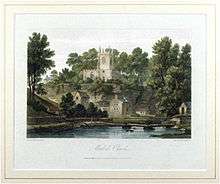John Byrne (English artist)
John Byrne (1786–1847) was an English painter and engraver.

Life
He was the only son of engraver William Byrne and followed his father's profession in the arts.[1] After his father's death in 1805, he moved to 54 John Street, London. He provided sets of engravings for Charles Wild's works on cathedrals.[2]
Byrne around 1818 was drawing-master at Eton College.[2] He subsequently concentrated on landscape painting in watercolours; his sister Mary and her son were also painters.
His work is included in Cadell and Davies' Britannia depicta. He sent pictures to the exhibitions of the Water-Colour Society and the Royal Academy; and spent some years (about 1832-37) in Italy. He died in 1847. In the Victoria and Albert Museum are:[1]
- The Ferry at Twickenham (exhibited in 1830).
- Italian Landscape, with Monastery.

References
- Bryan, Michael; Robert Edmund Graves, Sir Walter Armstrong (1886). "Dictionary of painters and engravers, biographical and critical". Internet Archive (3 ed.). London: G. Bell & Sons. p. 206. Retrieved 30 April 2017.
- Clayton, Timothy; McConnell, Anita. "Byrne family". Oxford Dictionary of National Biography (online ed.). Oxford University Press. doi:10.1093/ref:odnb/65026. (Subscription or UK public library membership required.)
| Wikimedia Commons has media related to John Byrne (artist). |
- Attribution
![]()